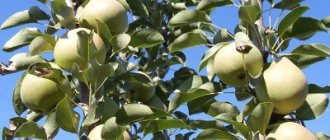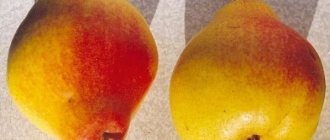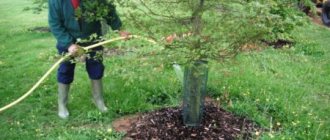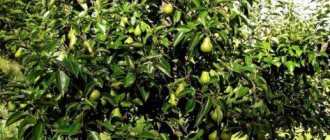Description of the pear variety Hera
The tree has a narrow pyramidal crown and grows up to 4 m in height. Fruits are formed on both annual shoots and perennial branches. They are straight, medium in thickness, brown in color, without hairiness.
The buds are medium in size and round in shape, tightly pressed to the branches. The leaf blades are dark green in color, with a shiny and smooth surface, medium in size and oval in shape.
Hera pear flowers are white in color with white petals. The process of budding and opening occurs at the end of spring. The flowers are up to 3 cm in diameter and almost completely cover the trunk.
Reproduction methods
A hybrid culture can be propagated in several ways. Gardeners practice the layering method, growing pears from cuttings, and grafting to various fruiting rootstocks. The last option will be the most successful.
There are several grafting methods:
- Copulation. The work will bring the expected result only if the seedling of the rootstock and the Hera scion are the same in thickness. For grafting, you will need to make oblique cuts on the crops, attach the rootstock and scion to each other in these places. The junction must be wrapped with cloth or film.
- Copulation “with a tongue”. By analogy with the first method, oblique notches are made on the rootstock and scion with a sharp instrument. After that, the cutting of a varietal pear is applied to the selected seedling so that its “tongue” goes behind the “tongue” of the rootstock. The vaccination is secured with adhesive tape or film.
- Bark grafting. The method is suitable for cases where the thickness of the cutting is less than the selected rootstock. The cut on the cutting should be horizontal, it is cleaned, a longitudinal cut is made in the bark, 2-3 cm deep. The bark is carefully folded over the rootstock, and a previously cleaned cutting is inserted into this place. After treatment with garden varnish, the graft must be wrapped in transparent film for fixation.
- Cleft grafting. The rootstock is trimmed, a horizontal cut is made on it, the trunk is split in the center by 3-4 cm. A temporary wedge is inserted into the gap. A cutting with 2-4 buds is selected, and a wedge-shaped cut is made on it. Then the scion is inserted into the split, while the wedge is removed. The sections are treated with garden varnish, and the grafting site is additionally fixed with film.
Fruit characteristics
According to the description and photo, the Hera pear bears large fruits 4-5 years after planting, their weight ranges from 180 to 250 g. The skin is green, of medium density, and changes color to yellow as it ripens. A slight pinkish blush may be present. The core is round in shape and contains oblong brown seeds.
The pear pulp is fine-grained, cream-colored, and very juicy. Granulations (fossilized inclusions) may occur in fruits. According to the taste characteristics, Gera pears are sweet and sour, rated at 4.3 points. The fruits have an unobtrusive subtle aroma.
Important! The yield and taste of fruits are affected by soil quality, climate and lighting.
Violation of the rules of planting and care are factors contributing to the premature death of the plant.
Harvest and storage
The keeping quality of “Hera” fruits, as noted above, is excellent. If the humidity is 80-85% and the temperature is from 0 to +4 degrees, fresh fruits are stored for about five months. For storage, fruits are removed in dry weather and unwashed are placed in wooden boxes, each layer being lined with food paper. At the same time, it is important that the fruits do not have even the slightest damage and that the stalk of each is preserved.
The variety is ideal for the capricious and unpredictable climatic conditions of Russian regions. Without requiring special care, the pear annually produces stable harvests of tasty fruits, which perfectly compensate for the lack of vitamins in the winter.
Advantages and disadvantages of Hera pear
According to the description and reviews, the Gera pear variety is preferred to be cultivated in central Russia. The variety is known among gardeners due to the following qualities:
- high yield over a long period of time;
- frost resistance (up to - 38 ° C);
- high shelf life and the ability to transport over long distances;
- resistance to scab, septoria.
Important! Hera pear is a late-ripening variety; this feature should be taken into account when choosing a seedling.
No obvious deficiencies of the variety have been identified, but the fruits of the Gera pear lose their marketable appearance (darken) if the rules of transportation and indoor storage are violated.
Care
The cultivation of pear trees is not particularly complicated, but it does require a little time and effort. You can learn more about how to properly care for the Hera pear variety in the articles at the links.
How to care for a pear Pruning a pear Pruning a columnar pear Treating a pear from diseases and pests Feeding a pear How to water a pear
Optimal growing conditions
Pear grows wild in the countries of Europe and Central Asia, where it is a deciduous thicket. The fruits of this plant are small and have low taste.
In its cultivated form, Hera pear is grown in household plots located in the Urals, Western Siberia, Ukraine and Belarus, Japan and China. This wide distribution is facilitated not only by high yields, but also by ease of care and high frost resistance.
The optimal conditions for cultivating pears are fertile and loose soil with neutral or reduced acidity. On acidic or waterlogged soils, the seedling has difficulty taking root, produces a meager harvest or does not bear fruit.
Planting and caring for Hera pear
In autumn, it is preferable to transfer seedlings into the ground if the region has moderate climatic conditions without sudden changes in weather. If planting is successful, the first harvest is harvested after 4-5 years, and maximum fruiting is noted in the 10th year of growing the variety.
Landing rules
It is necessary to allocate a place on the site with sufficient lighting and absence of drafts. Before planting, dig a hole with a diameter of 80 cm and a depth of 1 m. If sandy soil predominates, peat is added to the humus in a ratio of 1:2.
The planting site is prepared a week before transferring the seedling to the site. Fertilizers with humus are added to the hole and filled with a bucket of water, add 3 tbsp. spoons of potassium sulfate. The next day, the humus is mixed and another 3 buckets of water are added. It is recommended to replant the variety a week after digging a hole.
Important! Hera pear seedlings do not take root well and grow slowly over 3 years. This is associated with poorly developed rhizomes.
A day before transferring the plant to the ground, it is left in a bucket of water to start biological processes in the seedling.
The Hera pear is placed in a hole and covered with soil. At the end of the procedure, the earth around is compacted and a hole is formed. The seedling is watered abundantly.
To prevent damage to the pear, it is recommended to construct a support from a wooden stake to which the trunk of the plant is tied.
Caring for the seedling consists of abundant watering for the first 30 days: 2 times a week. After the pear has rooted, the soil is moistened less frequently: before and after flowering and in the fall. The plant does not require insulation, so annual plantings are covered with snow. This procedure is not required in subsequent years.
Watering and fertilizing
Hera pear is drought-resistant, but to obtain the maximum amount of harvest, it is necessary to ensure soil moisture during the flowering period and after it. The irrigation rate for the seed is calculated: 3 buckets of water are poured per 1 m2 of soil. The procedure is carried out both by sprinkling and by irrigation furrows.
The procedure is carried out in the evening to avoid liquid getting on the leaf plates. For sprinkling, it is recommended to use special sprayers.
For surface watering in a circle around the trunk, the soil is loosened and grooves 10 to 15 cm deep are formed.
To prevent the soil from drying out, it is mulched with available materials (chopped straw, sawdust, leaves).
To maintain soil fertility, it is necessary to regularly apply fertilizers to it: in spring, summer and autumn. During the flowering period, the pear actively absorbs nitrogen, so fertilizers containing it are applied by scattering along the edge of the tree trunk.
In summer it is recommended to use complex supplements. In the fall, after fruiting has ended, preparations containing phosphorus and potassium are added to the soil.
Trimming
The procedure can be carried out regardless of the time of year. For crown formation, it is recommended to give preference to the autumn period. In spring, it is recommended to remove shoots that have frozen over the winter.
Important! If it is necessary to completely remove the shoot, pruning is carried out so that no stumps remain on the pear: at the base of the branch, near the trunk, there is a “ring”, which is the optimal place for cutting.
General recommendations for pruning Hera pear:
- heavily dense branches are thinned out to ensure full access to sunlight;
- trimming the trunk by ¼ helps prevent excessive growth of the variety;
- the cut site is treated with special preparations or garden varnish;
- Branches with signs of disease, dried out or growing at right angles must be removed.
If pruning needs to be done in the fall, then the optimal time is the beginning of October, when the foliage completely falls from the pear. When carrying out the procedure in the spring, wait until the end of February or the beginning of March.
Whitewash
To protect tree bark from sunlight, pests and temperature changes, whitewashing is carried out. It is recommended to perform the procedure twice: in spring and autumn. The preferred time for whitewashing is the end of fruiting (October-November).
If it is not possible to carry it out in the fall, it must be done in February to prevent cracks in the bark as a result of night frosts.
To prepare whitewash, dilute 3 kg of slaked lime, chalk or copper sulfate in 10 liters of water, then add 2-3 tablespoons of flour paste (you can replace 100 g of casein glue). The resulting mixture is thoroughly mixed and left to brew.
Important! For maximum protection, it is necessary to whitewash the lower third of the skeletal branches and the trunk. Mature trees cover a height of 18-2 m.
Before carrying out the procedure, you need to prepare the bark of the Hera pear: clean the trunks and branches of lichens and old bark. The use of metal knives and brushes is prohibited, as there is a high risk of damage to the plant.
Everything that was removed from the trunks and branches must be burned, and the peeled bark must be disinfected. To do this, in dry, windless weather, it is treated with a 5% solution of copper sulfate. If necessary, it is replaced with the drugs Abiga-Pik or Oksikhom. It is recommended to spray using a spray bottle.
Preparing for winter
At the end of fruiting, fallen pears and leaves are collected and burned, the soil is dug up and fertilizers are applied.
The Hera pear is frost-resistant, but for the purpose of prevention, the soil around the trunk is mulched using sawdust and humus.
To prevent rodents, the trunk is wrapped with mesh or any covering material. When preparing a seedling for winter, its branches are tied.
Landing rules
Gera pear is planted using standard technology for the culture. The seedlings have a high survival rate; in rare cases, the material does not take root. With the correct location on the site and subsequent care, the plant can bloom in the 4th year of the growing season.
Recommended timing
Hera pear is planted in the central part in spring or autumn. In the first case, work is carried out when the soil is ready to prepare the planting hole, around the end of May. In the second option, so that the seedling has time to take root before the onset of frost, approximately in early September.
In the European part, it is better to refuse autumn planting; the weak root system of the seedling will not be able to withstand severe frost, and the pear will die. In spring, the variety is planted at a soil temperature of +14-160 C.
Site selection and soil preparation
The main condition when choosing a site for a variety is the complete absence of shade. Pear Hera is not afraid of drafts and strong gusts of wind. Wetlands are not designated for planting; the variety will not take root in waterlogged soil. It will not grow in heavy, poor soils. The best option for Hera is neutral aerated soil, loamy or sandy loam. Do not consider sour and salty ones.
The hole is dug a week before planting, with a depth and width of 80 cm. The bottom is covered with broken bricks, and the top is covered with a layer of gravel. Mix humus and sand in equal proportions, pour about three buckets onto the drainage pad. The pit is filled with water.
Selection and preparation of seedlings
The optimal age for a seedling is two years, but one-year-old planting material can be used. The pear must be free of mechanical damage and dry fragments in the root system.
The grafting site should be clearly visible on the planting material - this is a small compaction in the area of the root collar. Before planting, the root is treated with an antifungal drug and placed in a growth stimulator.
Important! The concentration of the solution and treatment time are according to the instructions for the product.
Landing algorithm
Mix three buckets of compost and two buckets of sand, add potassium sulfate and superphosphate. Pear planting technology:
- A portion of the substrate is poured into the bottom of the pit, and a cone-shaped mound is made in the center.
- They retreat 20 cm from the top of the embankment and dig in a fastening stake.
- The seedling is placed vertically on a hill, the roots are evenly distributed over the mound.
- Pour out the rest of the mixture and compact it so that there are no voids left.
- The hole is filled to the edge with soil, the root collar is left above the surface.
- The seedling is fixed to a stake.
- Water, dig a shallow, narrow trench along the edge of the planting hole for irrigation.
The next day, the pear is shortened to 50 cm, and the area near the trunk is mulched. Pruning is necessary to form the crown, and mulch is necessary to retain moisture.
Productivity
The Hera pear is characterized by high yield: up to 40 kg per tree. For harvesting, cloth gloves are used, separating the fruit from the tree along with the stalk.
For maximum safety of the pear, you must adhere to the following rules:
- the fruit is placed in a ventilated, dark place where the humidity is 85% and the temperature is up to + 1 ° C;
- put Hera pears in a wooden box with sawdust, where each fruit is wrapped in paper;
- overripe or spoiled fruits cannot be stored;
- Pears need to be sorted periodically; fruits with defects are disposed of.
Fruits can be frozen; cut fruits can be stored in the refrigerator for 24 hours.
Advantages and disadvantages
Each variety has its own advantages and disadvantages. Hera was no exception. Now we will tell you in detail about the pros and cons of this variety, so that you can finally decide whether you want to plant it on your site or not.
- Dimensions of the tree. As mentioned earlier, the trees of this variety of pears are small in size. Since one tree reaches about 4 m in height, they can easily be placed even in small areas. It is also worth noting that the crown, which has a pyramidal shape, contributes to the compact placement of trees.
- Rare crown. Since the tree’s crown is not thickened, you can easily carry out the necessary sanitary pruning. In addition, this reduces the risk of fungal diseases.
- Frost resistance. Since the tree can tolerate frosts down to -38 °C, it can easily be grown even in the coldest regions of our country.
- Keeping quality of fruits. The fruits have good keeping quality. If you comply with all the necessary requirements, you can store pears for up to 5 months. In addition, you can not only eat them fresh, but also use them for various preparations.
- High yield. This variety gives good stable yields. With proper care, you can harvest up to 40 kg of ripe pears from one tree.
- Mediocre taste. The tasting score is not too high - only 4.3 points out of 5, so do not expect outstanding taste characteristics.
- Susceptibility to pests. But this tree is very fond of being attacked by various insects, so treatment with insecticides is mandatory.
- Seedlings do not tolerate frost well. Unlike mature trees, seedlings will need to be covered for the winter to prevent them from dying.
- Not everyone can eat the fruit. Pears are not recommended for consumption by people suffering from diseases of the gastrointestinal tract.
Diseases and pests
Hera pear is resistant to diseases such as scab and septoria, but there are pests and diseases that can lead to the death of the plant.
Black cancer affects leaf blades, shoots and fruits. To get rid of it, the damaged bark must be removed and the trunk treated with garden varnish. Whole shoots are sprayed with copper sulfate.
Moniliosis is characterized by rotting of the fruits on the branch. Affected fruits that have fallen to the ground are collected and disposed of, and the tree is treated prophylactically with a phytosporin solution.
Powdery mildew is characterized by the appearance of a white coating on the leaf blades. As the disease progresses, they curl up and fall off. For treatment and prevention, the pear is treated with a solution of Fundazol.
Dangerous parasites for pears that can harm the variety:
- codling moth;
- green aphids;
- pear mite;
- psyllid
To combat pests, it is necessary to promptly remove and burn all foliage. Digging of the soil, whitewashing and regular inspection of the pear are mandatory.
History of selection and region of breeding
“Hera” owes its appearance to two parent varieties “Reale Turinskaya” and “Daughter of the Dawn”.
The variety was obtained at the All-Russian Research Institute of Genetics and Selection of Fruit Plants named after. Michurin, with the participation of such authors as S.P. Yakovleva, A.P. Gribanovsky, N.I. Savelyev and M.Yu. Akimova.
Included in the State Register for the Central Black Earth Region.
The following varieties thrive in this region: Duchess, Dessertnaya Rossoshanskaya, Moskvichka and Kosmicheskaya.
Reviews from gardeners about Hera pear
Samoilov Andrey Igorevich, 41 years old, Astrakhan
Hera pear is an excellent high-yielding winter pear variety. The tree has a neat crown and easily tolerates frost. The fruits are dense, but sweet, with a slight graininess. I store the harvest all winter in the basement: the taste and appearance do not change.
Kutuzova Lyudmila Ivanovna, 57 years old, Chelyabinsk.
In my garden, Hera pear is a favorite variety. The fruits are large, sweet and have a long shelf life. The tree requires care: feeding and pruning. Be sure to whiten the trunks and dig up the soil in the fall and spring. During 7 years of cultivation there was not a single year of poor harvest.
Reviews
Igor Nikolaevich, Lipetsk : The tree began to bear fruit 5 years after planting. We are pleased with good harvests every season. Overwinters with minimal losses. Pears are medium-sized, with thick skin, moderately sweet.
Oksana, Nizhny Novgorod : I like Hera for the high keeping quality of its fruits. Pears remain sweet even in winter and do not spoil in the cellar. I try not to skip watering in the summer, and also regularly fertilize.
Larisa Aleksandrovna, Chelyabinsk : An excellent option for those summer residents who are stocking up for the winter. Hera bears fruit every season, and pears are stored until the new year. The tree is frost-resistant and does not get sick.











